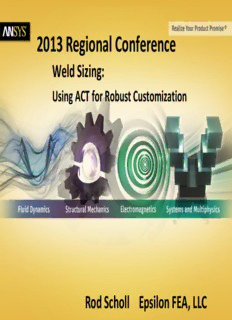
From APDL to ACT 3. The Weld Extension Details PDF
Preview From APDL to ACT 3. The Weld Extension Details
2013 Regional Conference Weld Sizing: Using ACT for Robust Customization Rod Scholl Epsilon FEA, LLC 1 ©© 22001133 AANNSSYYSS,, IInncc.. JJuunnee 1155,, 22001133 AANNSSYYSS CCoonnffiiddeennttiiaall Weld Sizing: Using ACT for Robust Customization 1. Weld Sizing – Historical Context 2. Customization – From APDL to ACT 3. The Weld Extension Details • Geometric Intelligence • Determining Required Weld Size • Plotting Results • Level of Effort ACT Module 2 ©© 22001133 AANNSSYYSS,, IInncc.. JJuunnee 1155,, 22001133 AANNSSYYSS CCoonnffiiddeennttiiaall Weld Sizing: Historical Context Weld Sizing often controlled by standards: AISC (American Institute of Steel Construction) AWS (American Welding Society) ASME Boiler Pressure Vessel Code (BPVC) IIW (International Institute of Welding) Historically sized with hand-calcs • Geared toward beams more than irregular geometry • Commonly uses Loads (Force and Moments) – Not stresses 3 ©© 22001133 AANNSSYYSS,, IInncc.. JJuunnee 1155,, 22001133 AANNSSYYSS CCoonnffiiddeennttiiaall FEA Models Increasingly Available FEA results are too localized – Singularities & Stress concentrations “Hot-spot stress” Methods 1. Expects explicitly modeled size/geometry & requires nodes at toe – Must iterate on weld size – Some methods expect shell models 2. Geared toward fatigue failure at toe 3. Is predictive, not specification-compliant Verity Method (Battelle, 2006) – Integrated into FE-Safe and Hypermesh – Has the three limitations above – Is insensitive to mesh density and has better correlation/acceptance Each company uses different specs, approaches, and methods! 4 ©© 22001133 AANNSSYYSS,, IInncc.. JJuunnee 1155,, 22001133 AANNSSYYSS CCoonnffiiddeennttiiaall Weld Sizing: Design for Manufacture Welding Manufacturing Costs are often nontrivial • Never-ending squeeze on labor/materials • Cost of FEA continues to fall (relative to build-and-test) – High cycle fatigue usually not testable at system level • Margins added on top of Safety Factors – Weld process has huge variability – Indeterminate physical material properties – Residual stresses – Weld length/flaw count adds statistical factor – Statically indeterminate loading (not a simple beam) • This portion of overdesign can be mitigated using FEA 5 ©© 22001133 AANNSSYYSS,, IInncc.. JJuunnee 1155,, 22001133 AANNSSYYSS CCoonnffiiddeennttiiaall Customization: From APDL to ACT The Power of Customization – Cost benefits • Automation usually has large ROI – Quality Benefits • Standardization/Codification of Design Process – Individual Benefits • Increasing individual contribution over time The Risks of Customization – Obsolescence (ANSYS development always adding features) – Version Repair / Upkeep / Training & Documentation 6 ©© 22001133 AANNSSYYSS,, IInncc.. JJuunnee 1155,, 22001133 AANNSSYYSS CCoonnffiiddeennttiiaall Customization: From APDL to ACT APDL (ANSYS Parametric Design Language) – Scripting in APDL has been viable bridge (snippets) Journaling / Scripting in Workbench allows for task automation – *DO loop functionality for repetitive tasks – Log File allows a low initial learning investment – Limited interaction with numerical model/results ACT (ANSYS Customization Toolkit) – New! – Full access and manipulation of the model / matrices via API’s – Can encapsulate legacy APDL scripts with low investment – Object Oriented! (Python) – ANSYS inc. committed to long term support – Expanding Library of Free Extensions (some open source) Downloads at the customer portal of http://support.ANSYS.com 7 ©© 22001133 AANNSSYYSS,, IInncc.. JJuunnee 1155,, 22001133 AANNSSYYSS CCoonnffiiddeennttiiaall ACT Released at 14.5 • Manageable learning curve – Python is within many graduates’ skill sets (Yes, we’re getting old) – Developers’ guide from ANSYS – Training is available – Basic Tool to browse Workbench API’s • Extension can call uncompiled APDL scripts – Do what you can in Python -- put the rest in APDL – Incrementally learn Python – Edit APDL without ACT license! • Robust Unit inputs • You get to make your own button icon …which is fun. 8 ©© 22001133 AANNSSYYSS,, IInncc.. JJuunnee 1155,, 22001133 AANNSSYYSS CCoonnffiiddeennttiiaall The Weld Extension The Weld Extension has four steps 1. Pass surface selection and results to Mechanical APDL Required because we are including an APDL core Mechanical will launch Mechanical APDL in background 2. Intelligent Geometry Recognition This is the challenging part 3. Load/Stress Calculation 4. Pass results back to WB and Plot 9 ©© 22001133 AANNSSYYSS,, IInncc.. JJuunnee 1155,, 22001133 AANNSSYYSS CCoonnffiiddeennttiiaall Step 1: Pass Selection and Results Pass surface selection and results to Mechanical APDL 1. This is simple (once you get the hang of it) Can enforce scoping to one type(s) of geometry In our case, it is restricted to two surfaces Enter other data in details window (as dropdown or variable) 10 ©© 22001133 AANNSSYYSS,, IInncc.. JJuunnee 1155,, 22001133 AANNSSYYSS CCoonnffiiddeennttiiaall
Description: